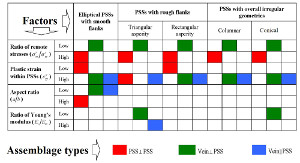| |||||||
|
|
|||||||
|
|
|||||||
| Mechanisms and Mechanics of Fracture Assemblages | |||||||
|
One of the most common basic structural assemblages includes joints and pressure solution seams (PSS). These are described under structure assemblages. Zhou and Aydin (2012) used the configuration in Figure 1 which is based on localized volume reduction structure (LVRS) of Katsman et al. (2006) to investigate the formations of the common structural assemblages of joints and pressure solution seams: orthogonal PSS sets, orthogonal PSS-Vein sets, and parallel PSS-Vein sets. As summarized in a table (Figure 2) various remote stresses, internal plastic strains, stiffness ratios, and geometries of LVRSs are considered. It is found that when PSSs have perfect elliptical shapes and smooth flanks, the conditions for generating fundamental assemblages are highly restrictive. However, there are a wide variety of loading and geometric factors favoring the formation of a specific type of structural assemblage. Among these are: (1) PSSs with roughness on their flanks and PSSs with overall irregular geometry are much more favorable for generating fundamental structural assemblages; (2) higher ratios of remote stresses are favorable for orthogonal PSSs; and (3) higher internal plastic strains enhance parallel PSS and vein formation. Other assemblages such as fault and joint assemblages and deformation band and joint assemblages are described under 'Splay Joints' and 'Splay Pressure Solution Seams.' | |||||||
| Types of Mechanisms and Mechanics of Fracture Assemblages: | |||||||
| Interaction of Joints and Pressure Solutions | |||||||
| Reference: |
|||||||
| Katsman, R., Aharonov, E., Scher, H., 2006 Zhou, X., Aydin, A., 2012 |
|||||||
|
Readme | About Us | Acknowledgement | How to Cite | Terms of Use | Ⓒ Rock Fracture Knowledgebase |
|||||||

